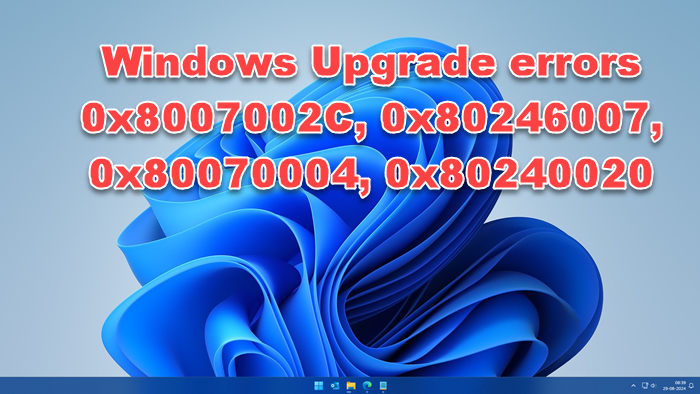There are many error codes for the Windows 11/10 Upgrade. In this post, we offer definitive fixes for Windows Upgrade errors 0x8007002C, 0x80246007, 0x80070004, and 0x80240020. All of these error codes are related to the problem with the Windows Update Folder. So, we will have to clear the Software Distribution folder, repair the System Image, and fix System Health.

Fix Windows Upgrade Errors 0x8007002C, 0x80246007, 0x80070004, 0x80240020
Before you begin, you might want to temporarily disable your security software, disconnect your peripherals, remove any USBs, and ensure that you are connected to the Mains power supply.
1] Delete Windows Update Files
Use Windows Explorer to navigate to “C:\Windows\SoftwareDistribution\Download” and delete the contents of the SoftwareDistribution folder.
Next, open Command Prompt as Administrator and then execute the following command:
wuauclt.exe /updatenow
Finally, open Settings and check for Windows Updates. Windows 10 should begin downloading.
You must have enough space in your C drive; otherwise, Windows Update will get stuck again. If you cannot, move the Windows Update download folder to another drive or use external storage.
Related:
- Windows Update Error 0x80246007
- Error 0x8007002C – 0x400D, We couldn’t install Windows
- 0x80070004 – 0x3000D, The installation failed with an error during MIGRATE_DATA operation
2] Use the DISM Tool
This tool fixes a corrupt system image. With admin privileges, you will need to use the following commands to fix them.
Dism /Online /Cleanup-Image /CheckHealth
Dism /Online /Cleanup-Image /ScanHealth
Dism /Online /Cleanup-Image /RestoreHealth
If the Windows Update client is broken, run the following to fix it. Then restart your PC and click on Update again.
DISM.exe /Online /Cleanup-Image /RestoreHealth /Source:C:\RepairSource\Windows /LimitAccess
3] Error 0x80240020
This is an expected error message if the upgrade requires customer user action.
For Error Code 0x80240020, we recommend you to also do the following. Open regedit and navigate to the following key:
HKEY_LOCAL_MACHINE\SOFTWARE\Microsoft\Windows\CurrentVersion\WindowsUpdate
Now in the left pane, right-click WindowsUpdate and create a new key here and name it OSUpgrade. Next, in the left pane, right-click in an empty area and create a new DWORD called AllowOSUpgrade and give it value 1.
If this does not help, you could perform a Clean Boot and run Windows Update.